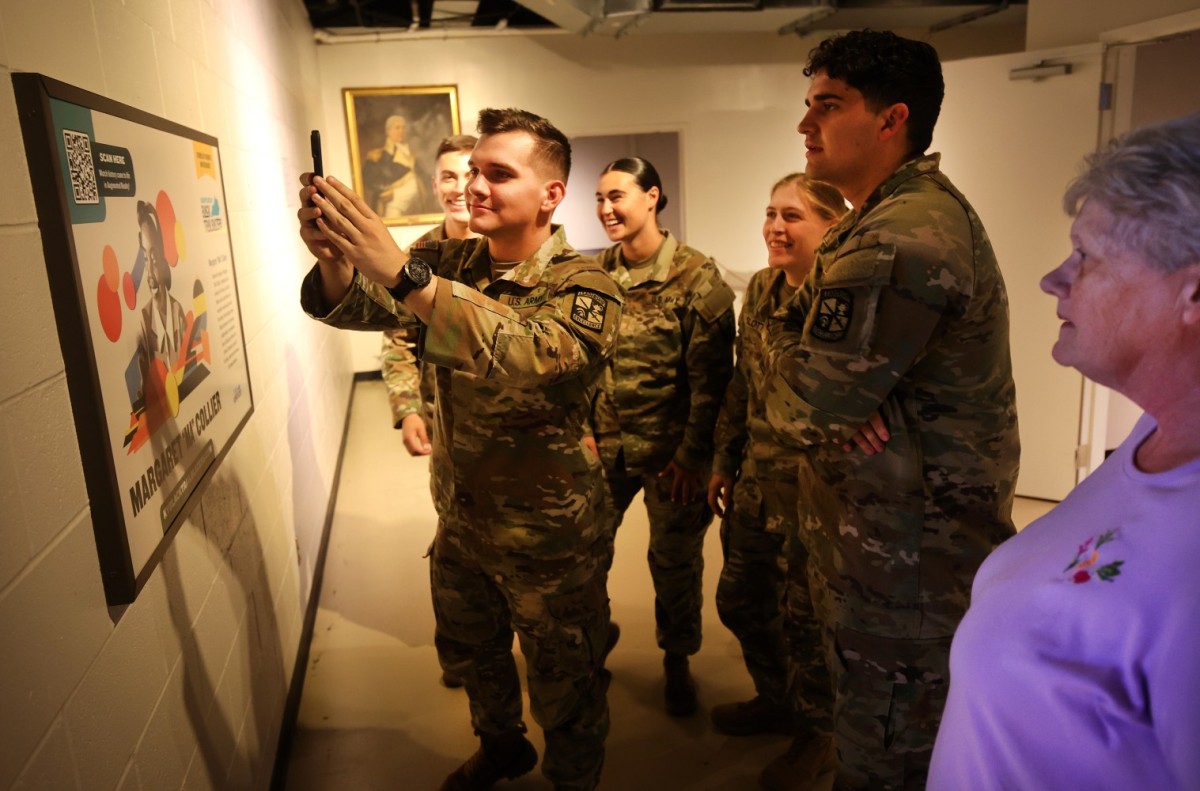FORT KNOX, Kentucky. — “Fort Knox has always been fortunate to have liberal-minded people at the helm. Even when the post was still racially segregated, every commander was very interested in the problems of the black personnel and did everything in his power to make the black soldiers aware of the role they played in the defense of their country.”

Cadets working at the General George Patton Museum of Leadership try out the new URL code for Margaret “Ma” Collier, presented by the Kentucky Black Trailblazers Initiative. The interactive website features a 3D version of Collier, portrayed by an actress, who talks about what life was like at Fort Knox for black soldiers before, during and after World War II.
ORIGINAL ADVERTISEMENTS
So begins a draft of an autobiography by Margaret “Ma” Collier, a trailblazing black woman from New York who traveled to the post in 1942 to lead an all-black service club. She is one of 19 black Kentuckians featured on Kentucky Black Trailblazers, a website dedicated to educating Kentuckians and others about the accomplishments of black people who helped shape the state’s history.
The website uses augmented reality to tell its stories.
“Augmented reality is a technology that overlays digital content such as images, videos and animations onto the real world, creating a unique and interactive user experience,” says the website at https://kentuckyblacktrailblazers.com/. “By using AR, Kentucky Black Trailblazers transports you into the life and times of each of the 19 stories featured and allows you to interact with the legacies in a whole new dimension.”

Ma Collier’s URL displayed in the museum opens on a mobile phone as if Collier were standing directly in front of the viewer, similar to Pokémon GO.
ORIGINAL ADVERTISEMENTS
As part of the Kentucky Department of Tourism, members of the initiative stumbled upon Collier’s story after asking Ty Reid, director of the General George Patton Museum of Leadership, for suggestions.
“When Elizabethtown Tourism came to us over a year ago and said, ‘Hey, we’re going to have a couple of stops here in Hardin County. One of them should be a Fort Knox stop,’ we suggested Ma Collier,” Reid said. “We have her archives here.”
Reid said Collier was not only a pillar of black history at the post, but also a wrecking ball for racial segregation.
“Here is this incredible, very local story that takes place within this timeline. Here is this woman who works and toils for these soldiers who are systematically abused,” Reid said. “But then when that system goes away, she says, ‘My work is not done. I am going to stand up for all soldiers now.’
“That’s why they called her Ma; she was basically everyone’s mom and very respected.”
Reid said Collier’s father, who had served honorably as an Army first sergeant, instilled in her a desire to serve as a civilian. America’s inevitable war with Germany, Italy and Japan led Collier to Fort Knox.
“She was there to keep the morale of the African-American troops up,” Reid said. “She worked very closely with the garrison commander at the time, Col. (NB) Briscoe, and really made sure the African-American troops were taken care of.”
Collier reflected on her relationship with Briscoe in her autobiography.
“When I arrived at the post in February 1942, there were fewer than 200 black soldiers here,” wrote Collier. “The post commander told me I was more than a service club hostess. ‘My job is to keep the morale of the men high,’ he said, ‘and to keep him informed of any problems that might arise among the black personnel.'”
Collier took her role as host seriously. She managed to invite some of America’s most famous black celebrities to her club. Her exclusive list included boxing legend Joe Louis, jazz trumpeter Louis Armstrong, singer Lena Horne and Olympic gold medalist Jesse Owens.
Their ability to attract major celebrities became fertile ground for white leaders to celebrate military life alongside black soldiers.
When World War II began, efforts to desegregate soldiers and promote equality began at Fort Knox. Reid said Collier was at the center of all of that.
“Ma Collier was in a key position to advocate for black soldiers. Her advocacy efforts and the listening ear of key commanders like General (Jacob) Devers were the combination needed to achieve desegregation,” Reid said.

Ma Collier is buried in St. Patrick’s Cemetery across from Fort Knox Post Cemetery. True to her life’s work, she still takes care of “my boys.”
ORIGINAL ADVERTISEMENTS
Collier also praised Fort Knox leaders for their willingness to break down the barriers of racial segregation.
“Throughout my service here, every new commanding officer has expected this (the mission of keeping the morale of the men high) of me; and I have served in that capacity, acting as an advisor and counselor to countless black and white soldiers who have been and are stationed at Fort Knox,” she wrote.
Reid said Collier’s quiet determination and optimistic willingness to selflessly serve all Soldiers gave her a rare opportunity to get ahead of the curve and shape the military landscape of equality. Because of that and her lifetime of dedicated service to the Army, he immediately offered her name to the initiative.
“We’re excited to be a part of it. Collier’s story actually tells a local story that’s relatively unknown,” Reid said. “Fort Knox has a national story that everyone understands pretty well when it comes to civil rights and other things that happened nationally. Ma Collier tells both the local and national story, and it does it from a civilian’s perspective.”
————————————————– ——————–
Editor’s note: For more information about Ma Collier’s story, see this article: Biography of a black leader shows her influence on Fort Knox during and after World War II | Article | The U.S. ArmyIf you want to learn more about Collier, you can visit the General George Patton Museum of Leadership on Highway 31W north of Fort Knox.

